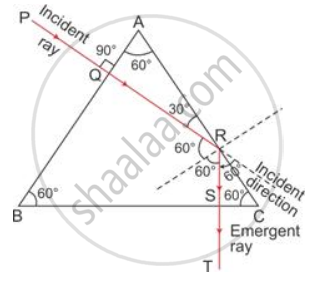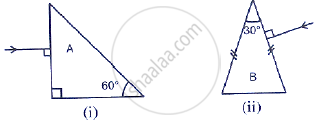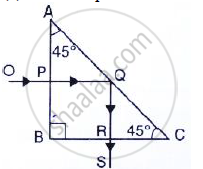Advertisements
Advertisements
Question
A total reflecting equilateral prism can be used to deviate a ray of light through:
Options
30°
60°
75°
90°
Solution
60°
Hint:

APPEARS IN
RELATED QUESTIONS
Fig 4.31 below shows a light ray of single colour incident normally on two prisms A and B. In each case draw the path of the ray of light as it enters and emerges out of the prism. Mark the angle wherever necessary.

A coin is places at the bottom of a beaker containing water (refractive index = 4/3) to a depth of 12 cm. By what height the coin appears to be raised when seen from vertically above?
The critical angle for glass-air is 45° for the light of yellow colour. State whether it will be less than, equal to, or more than 45° for (i) ref light, (ii) blue light?
A ray of light OP passes through a right angles prism as shown in the adjacent diagram.
(a) State the angles of incidence at the faces AC and BC.
(b) Name the phenomenon which the ray suffers at the face AC.

-
- the angle of refraction and
- the angle of deviation for the ray?
The critical angle for glass-air interface is :
Name one main factor on which the direction of bending of a ray of light depends.
During sunset and sunrise, the sun is seen when it is slightly below the horizon. Give reason.
A coin placed at the bottom of a beaker appears to be raised by 4.0 cm. If the refractive index of water is 4/3, find the depth of the water in the beaker.
Observe the figure and name the ray AB, ray CD, ray GH.

